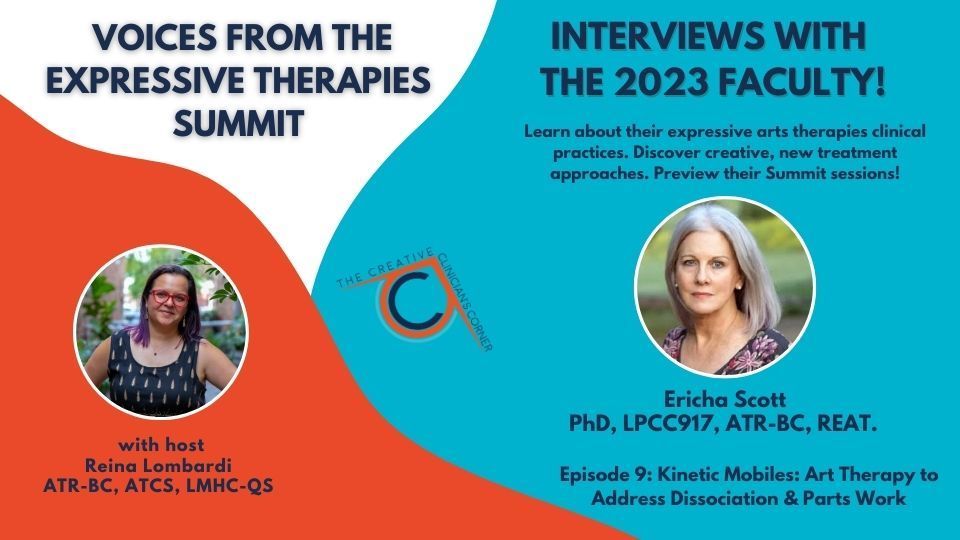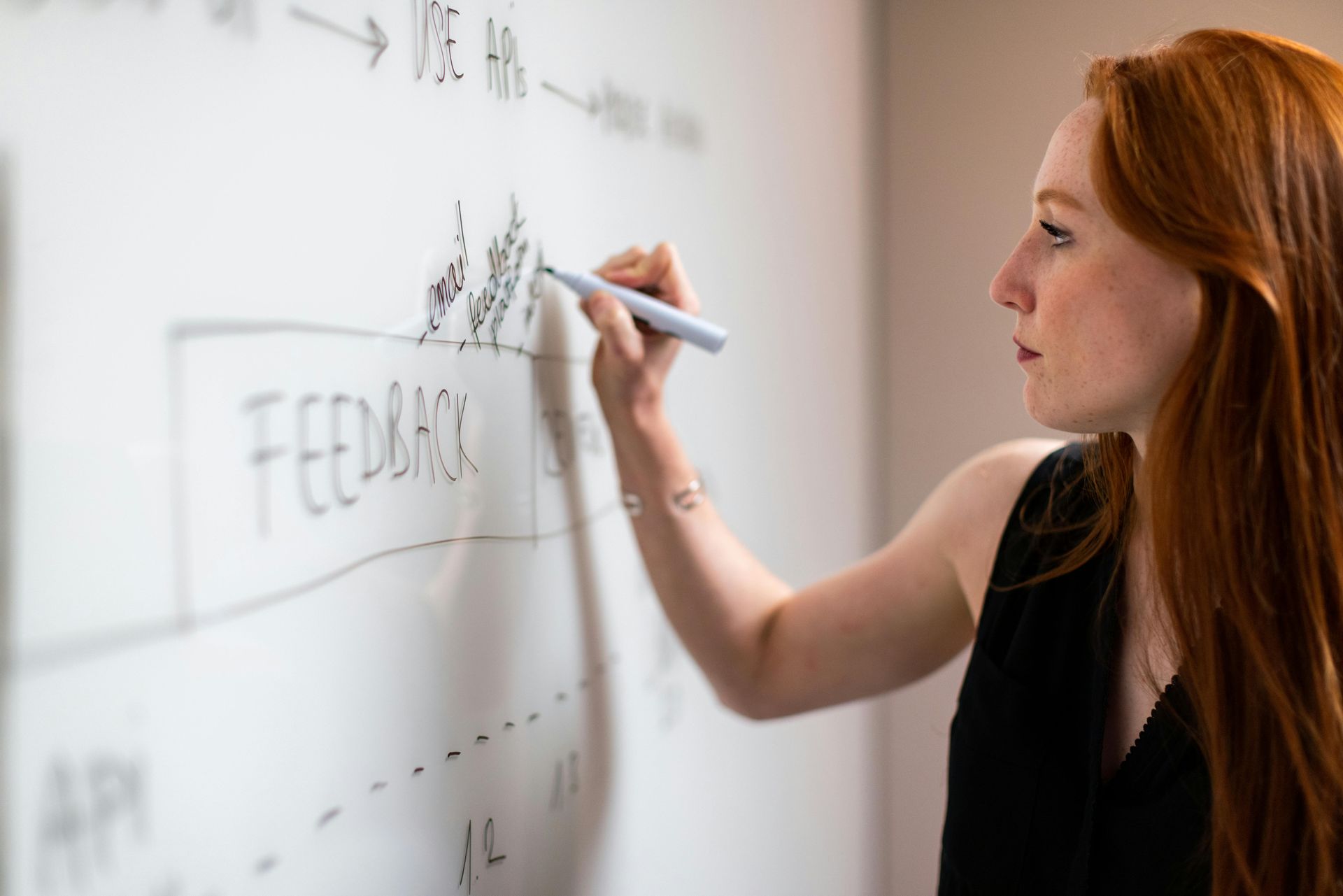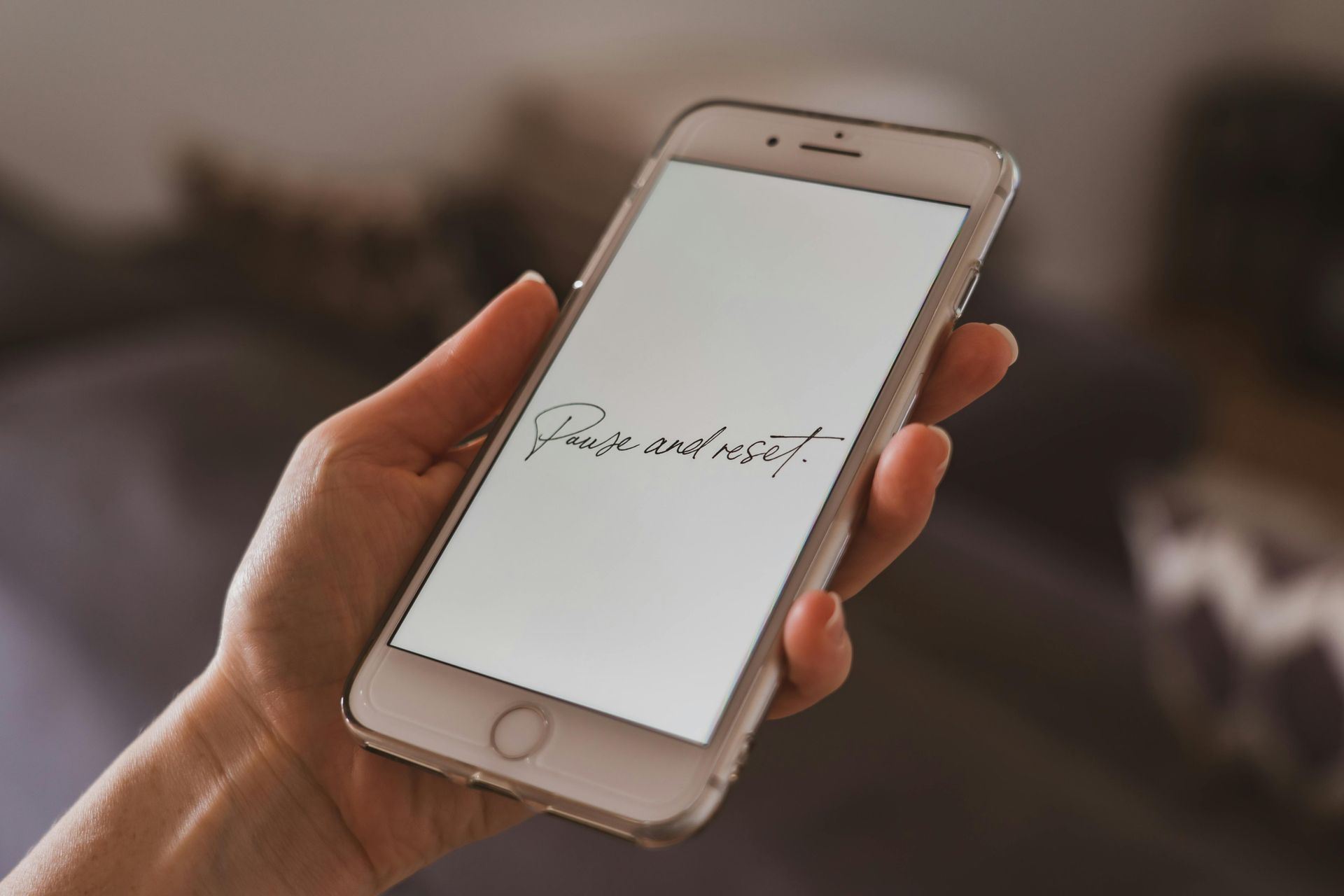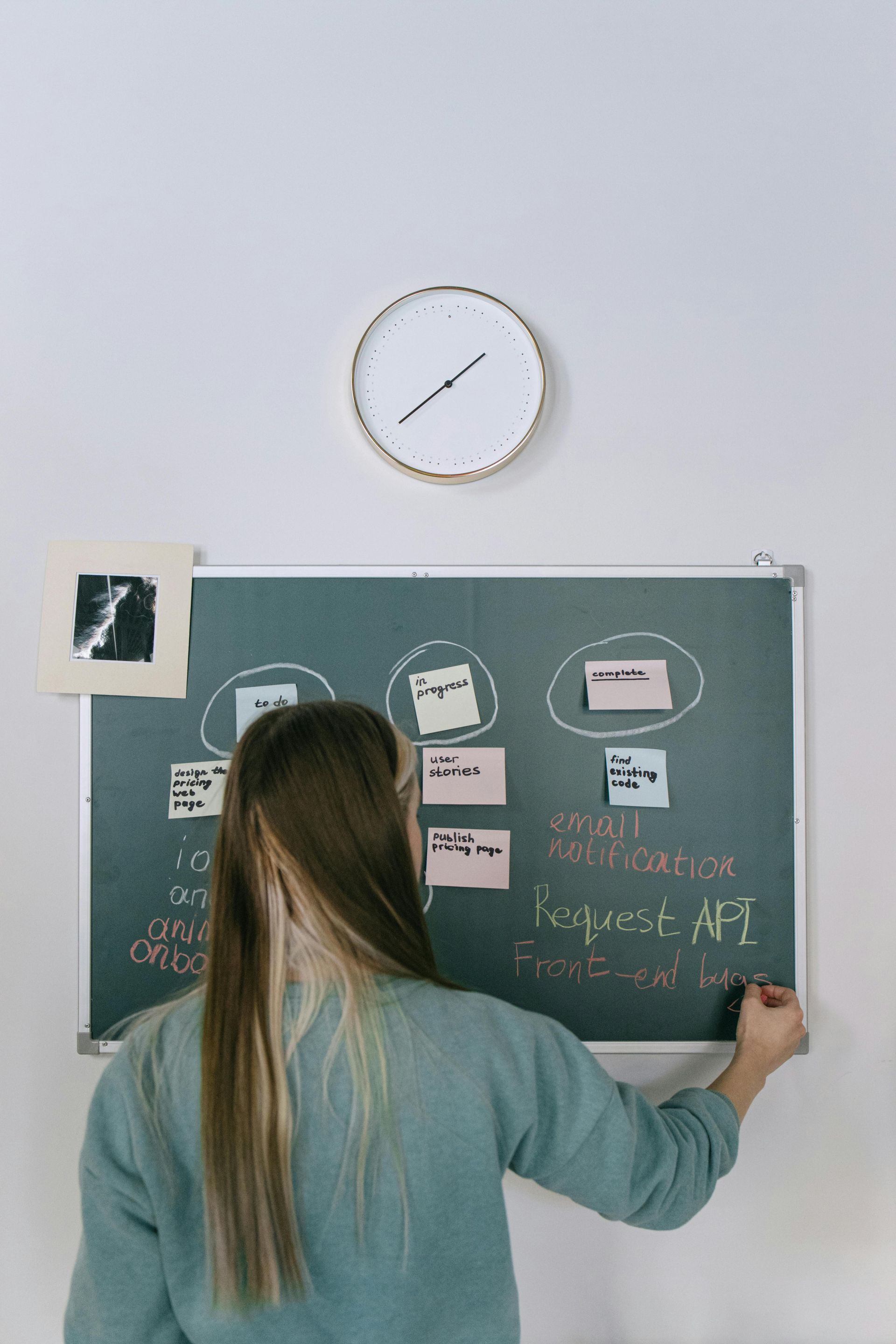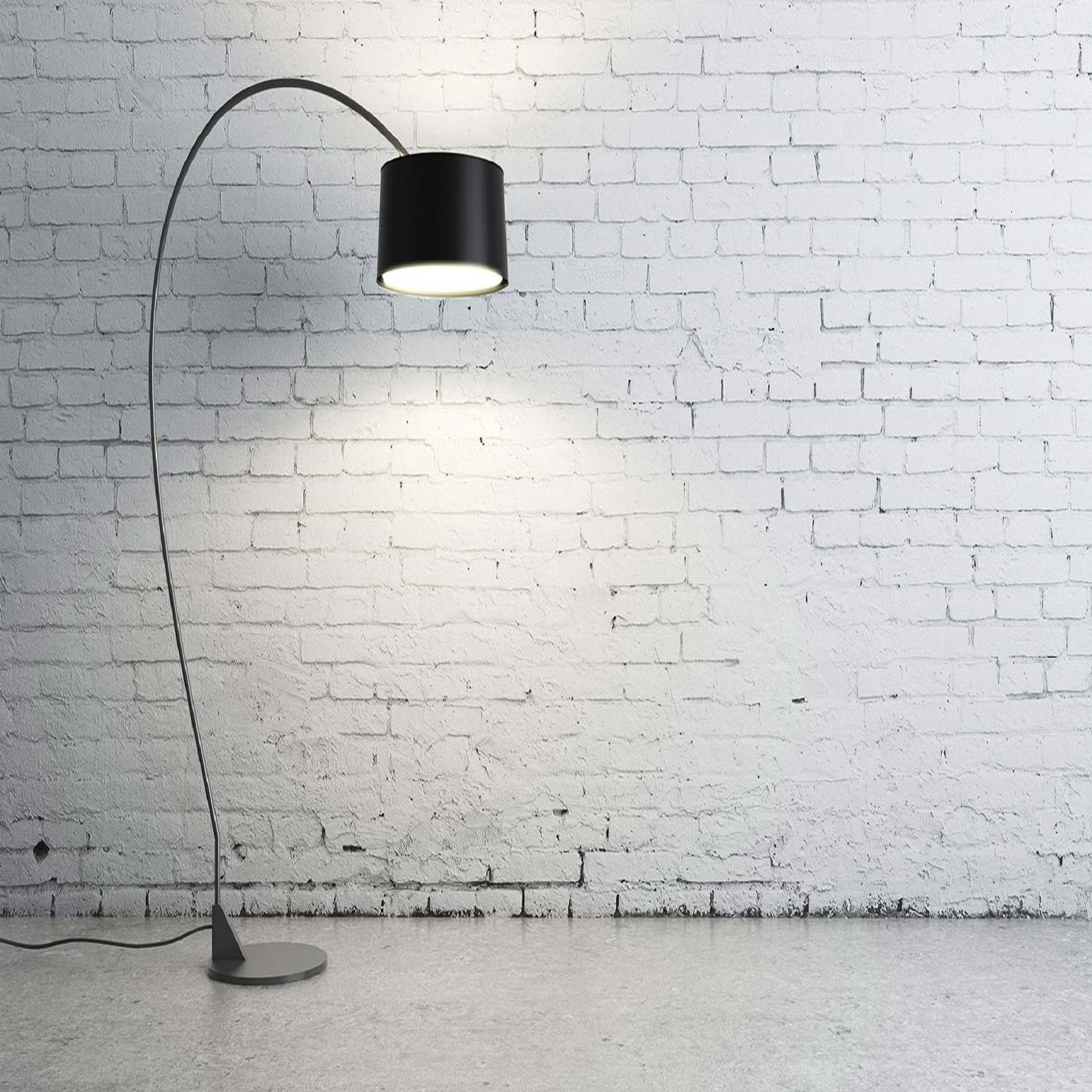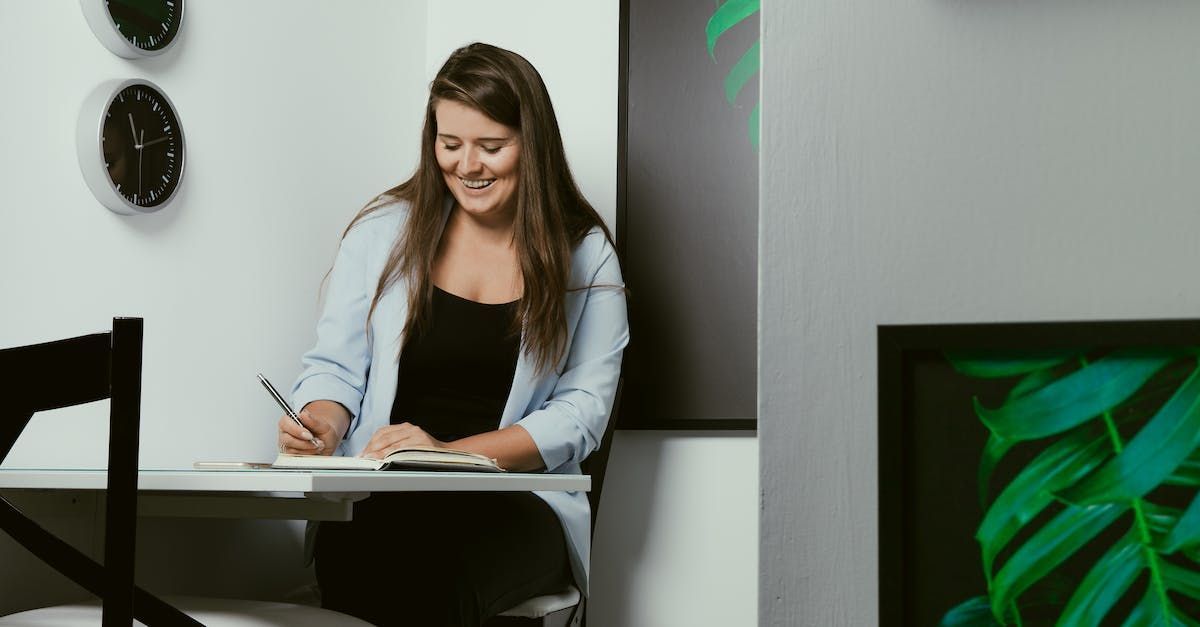VFTS 2023 9 | Ericha Scott | Kinetic Mobiles: Art Therapy to Address Dissociation & Parts Work
FEATURED GUESTS: Ericha Scott is an authentic, dedicated, and passionate, licensed and certified creative arts psychotherapist, artist, author, and advocate for disempowered populations. For 39 years, she has worked with those who struggle with substance and behavioral use disorders, victims of trauma, complex trauma, torture, dissociation, and victims of sex trafficking. Her commitment to health, wellness, and art as medicine includes experiential teaching professional clinicians’, medical doctors, the public, and for her own personal health journey. Her investment in social change via the arts across the world includes travel, presentations, collaboration, and cultural exchange in 4 continents. Her worldwide workshops bring hope and healing to diverse populations.
LISTEN & LEARN:
- Engaging clients through life size body mapping.
- How Ericha came to using kinetic mobiles in her work with parts and dissociation.
- The value of engaging in one's own arts practice as a means to longevity in the profession.
RESOURCES MENTIONED ON THE SHOW:
- https://artspeaksoutloud.org/ for more information
SESSIONS AT THE SUMMIT:
- Friday November 3rd, 2023 12:00PM-7:00PM
Mapping Inner Worlds Dynamically: Mobiles for Insight & Dissociative System Management
- Cultivating Self-Compassion, an experiential intermodal expressive arts session for all counselors and therapists, offers an opportunity to build skills of self-compassion using imagination and expressive media. Drawing upon imagery and contemplative practice, participants will identify ways to provide self-compassion in response to emotional pain and difficulty. They will discover a creative approach to working with themselves and others to provide tools of self-compassion that contribute to healing and growth. Through the introduction of simple expressive arts practice, participants will consult their own inner knowing and be guided through a simple, nourishing experience that can easily be taught to their clients in treatment in virtually any clinical setting. Participants in this 3-hour virtual workshop will be invited to share the gifts that their images bring, connect within and in community, as well as witness their own and others' compassionate presence.
Thanks so much for listening to the Creative Psychotherapist podcast. I am excited to share
with you this next episode, episode nine from 2023's series from the Voices of the Expressive
Therapy Summit, where I interview different therapists and professionals that are presenting,
speaking and facilitating workshops at the Expressive Therapy Summit events. If you've
never been to an Expressive Therapy Summit, what you can expect is highly experiential
participatory learning, where you're getting a deep dive into the creative process while
you're learning how these methods and interventions can be used and benefit the work that you're
doing with clients. I often feel like it is one of those opportunities where you are giving
to yourself in as much as you are learning to be able to facilitate these processes with
others.
Today I'm speaking with Erica Scott and she has been working in the field for multiple
decades and she's a registered Expressive Arts Therapist as well as a registered board-certified
art therapist. Her focus has been working using the arts with individuals that have experienced
various levels of complex trauma and she specializes in working with dissociation and
her presentation is going to be part of the dissociation track that the summit is offering
at the virtual event this November, where there's a number of different presentations that
are focusing on that topic. So if that's an area that you want to further explore and
develop, it might be a great opportunity to learn from people who have been practicing
for their career.
Doing this work, Erica shares some really cool interventions that she's
been using for a really long time with her clients and I think if you are someone that works
with individuals who've experienced trauma, this would be a great training to participate
in. It's going to be on November 3rd from 12 p.m. to 7 p.m. Eastern Standard Time so it's
an entire day and she is going to include some didactic information but it's primarily
going to be experiential where you're going to be engaging in the creative process as part
of the learning experience. So if you want to learn more about her presentation or any of
the other presentations that the summit is providing, please check out www.expressivetherapysemit.com.
There you'll find a whole host of different events that are being offered throughout the
year that you can learn from really, really talented and accomplished therapists that have been
developing their particular approach for a really long time. I highly recommend checking
it out if you've never participated before. So without further ado, here's my conversation
with Erica Scott.
Thanks so much for listening to the Creative Psychotherapist. I'm your host, Raina Lombardi.
And I am delighted to welcome my next guest, Erica Scott, PhD and licensed professional
clinical counselor, board certified registered art therapist and registered expressive arts
therapist. She is an authentic, dedicated and passionate licensed and certified creative
arts psychotherapist, artist, author and advocate for disempowered populations. For 39 years,
she has worked with those who struggle with substance abuse and behavioral use disorders,
victims of trauma, complex trauma, torture, dissociation and victims of sex trafficking.
Her commitment to health, wellness and art as a medicine includes experiential teaching,
professional clinicians, medical doctors, the public and for her own personal health journey.
Her investment in social change, beauty arts across the world travels across the world includes
travel, presentations, collaboration and culture exchange and for continents. Her worldwide
workshops bring hope and healing to diverse populations. Thank you so much for being here,
Erica. Thank you. It's a delight to be here. I'm really excited to talk to you about your
work. You have a breadth of experience of working with very heavy therapeutic content.
How have the arts played a role in helping you to have such an enduring career? That's probably
one of the best questions any interviewer has ever asked me because it's critical to my
longevity. I love art. I love outsider art. I was a professional artist before I became an
art therapist. And I believe this sounds maybe corny and hopefully not reductionistic, but
I truly believe that the art clients make in session, heal them and me. There's something
about looking at productions made in session that I find no matter what the content, I find
it energizing and uplifting and they can paint the most horrific stories. But I know that
it means they're getting better, that they will get better, that they are healing, they're
in the process. But there's also the energetic aspect of color. There's the joy of spontaneity.
There's the relief of just literally almost vomiting your emotions on the page, right?
Yeah. And I just, I feel blessed. I call crayons and paint brushes my magic wand because now
the research is being to support what I've been saying for 40 years that art heals. There's
no question about it. And I believe more than just having an art therapist on staff, we need
to create programs where art is embedded in every aspect of the program. I agree wholeheartedly.
And while one or two hours a week helps, it's nothing like having a totally immersed program.
So for example, it's your Tucson when I was the trauma therapist for a dual diagnosis program.
And you can imagine the trauma that was coming to a residential program, right?
Absolutely. And so I had every single person in the group did a life-size silhouette with their
whole addiction, trauma, surgeries, you name it, physical health, everything on their body
map. It was the visual life story. And I had everyone do a timeline. So those things are
sort of stereotypical. And then everyone in my group also did a sand tray because I had
figurines in my office. And then often they would do other art assignments. And I had them
hang up on the wall, all of that, genograms, you name it, everything. And then tell their
life story from beginning to end. And the life story was told a little bit from a postmodern,
except for very much immersed in the trauma about what a survivor hero story they have.
Like that they have survived all of this. And then they could see it, the group could see it,
I could see it, and the visual cues. So I'm very visual as you can imagine. I'm more
kinesthetic ironically than visual, but I'm of course I'm very visual. And so seeing all
of their art on the wall gave me cues for opening questions to ask about where they might
be stuck or in denial or minimizing or justifying you know all of that. Oh sure. So and magic
happened one time a woman did and I have a release to talk about this story. She did her
body map and included trauma. But the irony is that it looks like a golden Tara. A gold
like the Eastern Asian goddess. So her mother made her wear funny hat. So she had this gold
peaked hat like Tara wears. She had a trauma where she had a big bruise or lump here in her
childhood. Well it looked like a bendy. Okay so it's like on the center of her forehead.
Right. You've seen the little red dot. Right. So it wasn't quite exact, but there it was.
And then she had scoliosis. So her back was curved and she drew her hands in a way. Excuse
me. That it looked like a mudra, like hand gestures. Wow. Right. So she had that kind of you've
seen probably sculptures of goddesses or paintings of goddesses where they kind of look
slightly twisted. They're back. Yeah. And then they're holding their hands in the sacred
symbols. Excuse me. I'm going to call for. And so I said that. I said it isn't this interesting
as a total reframe or transformation. It you look like a golden Tara and I explain what I just
explained to you. Another person in the group had a full Kundalini experience right there.
Wow. They almost looked out of their chair and they went, "Woof, what happened? What happened?"
I said, "I don't know what happened. Tell me." And he said, "It's like an energy hit the
base of my spine and shot out the top of my head." And I said, "Well that's an awakening of the
Kundalini." Wow. Fascinating. I think art opens that gateway to something more than just
therapy or psychology or I think it opens the gateway to other realms of consciousness and spirituality
and the force self and the way that I don't know. I think some somatic experiencing can get there, but
I've not seen any other treatment modality take people there. And often it's a surprise for them.
That's not where they think they're going. That's the funnest part I think about working with
adults, particularly like that population, dual diagnosis population, folks in substance abuse
treatment that oftentimes are kind of hesitant to like about this idea like what I'm not a
kindergarten nerd. What do you mean you want me to? And then they have that like full 360 degree
thing like, "Wow, I can't believe how much I got from that hour, that just that this small experience
that can be so transformative. And if we did what you're talking about, which is to say,
have that immersed throughout and embedded in all aspects of treatment, what could possibly happen
because of the way the art is a symbolic language or unconscious is make sense through symbols.
It's not logic. Right. So it really does have that interconnectedness.
And power. Yeah. So Andy Stropthrow approached me. He was our lead psychologist at the time and he was
doing the pre-test post-test for the groups. And he approached me and he said, "I want to show you
what's the results." And he turned page after page after page after people with, let me know how you
used to a title and a press and anxious and they were leaving happy. Which is like what they're there
for, right? They're there to reconnect with that love joy and sense of being human
that we're all here to experience. And it's the art to take people from that level of distress
and 30 days later they leave grounded, not a superficial happy, centered happy, of knowing who they are
and accepting all aspects of who they are. And he said, this is like, I've never seen results
like this and I said, it's the art. It's the art. It's amazing.
Yeah. I think as we, as we learn more about our brain and what our brain needs to thrive. Earlier before we started recording, we were talking a little bit about neuro stuff and you were talking about neuroplasticity and I think that there
is a direct relationship between art making and neuroplasticity. And part of it I think is because
it is a novel experience every time we engage with the materials. It's a new, fresh experience.
Even for a seasoned artist who's been creating for years and years and years and is very knowledgeable,
every time we engage it's a new delight, it's fresh. It's, it's, there's something. Desiaprised. Yeah.
That's brilliant because what generates new neurons is art, novelty and beauty.
And that's Ernest Rossi after he had his stroke. He was talking about covering from his stroke.
And Ernest Rossi was a protégé of Milton Erickson and a expert in trauma and his own right.
So you're right. So when you talk about novelty, that is one, that's so art itself is
healing and then the aspect of novelty of making your own art. And then even in my opinion,
ugly art therapy is beautiful. So there's a beauty. The witnessing. The witnessing of it. Yeah, which is
so important. Yeah. Yeah. So it's fun. I have always believed in art because I was considered to be
retarded as a child. And I nearly, I nearly failed birth rate twice, not just once twice.
And I overheard my art teacher. I mean, she went in my art teacher. She was my fourth grade teacher.
But she turned to my mother and said almost in an off-handed manner, you know, she really likes our,
why don't you get her in our teacher. So my mother hires a beat neck who I just loved and he taught me
how to paint. And by the end of fifth grade, I was reading college level. Wow. So I have never doubted
the power of art. And I always made that connection even though I was just a little kid.
I knew our had something to do with them. That's wild. That's incredible. Yeah.
I think it's interesting. You know, we have a sense of knowing when we're children, when we're small
children, we like come in. I think as we get older, you know, we're so used to dismissing,
dismissing children's insights as unknowing. But really, I think kids have a greater sense of
knowing the truth than those of us who've been here living for longer time. We might have some wisdom
about what it means to live here. But kids have a different sense of knowing of like what to do.
Even like you think about how they engage in play, right? They like know what to do to take care
themselves naturally if you allow them to, right? We don't have to. And they haven't been traumatized.
Yeah. Absolutely. But that brings me to earlier, you had said something about when the folks left the
program that you were working in that they had a connection with and an acceptance of all of their
distinct parts. Yeah. And I know that you're going to be presenting at the upcoming Expressive Therapy
Summit in November, November 3rd. It's virtual. And part of that, I think, feeds into
the topic that you're going to be talking about. I believe the session that you're teaching is called
mapping inner worlds dynamically, mobiles for insight and dissociative system management.
And I would love if we could spend some time talking about that because there's a clear connection,
with all the parts. And can you share a little bit about what that is, what that looks like?
How did you come to integrate mobiles, which I think is such a brilliant metaphor for it? But I would love
to hear from you. Thank you. So I began working with dissociative identity disorder in
1987 in Dallas. And God or spirit or energy or luck gave me the most gentle easy client to start with.
I was so blessed. And I nobody at that time really, we really didn't know exactly what we were doing.
But following the inner child work, it was the next step. So we did have through
P.M.L.D. work and Terry Kellogg's work and John Bradshaw's work. We did have a step on the path.
So I began using all kinds of mapping with DID, including the life size body maps. So that's the one
way I use the life size body maps that most people don't use it that way.
I ask people to paint their parts on their map, where they think they are, where what they their jobs, their likes, their
dislikes, their energy, their size, because often it's hard for child parts to get that the adult
is an adult. It's very helpful for the child parts to understand that the adult is big and can
protect them and talk there if he doesn't really break through that denial. So I was already doing that.
And it was the late 80s by the time I came up with the mobile idea and it had to do with balance
and the movement, like how the parts move. Different sizes, different shapes and
right and different, the executive control switch from the parts that lurk or hide inside.
lurk might not be the best word. Sometimes it's the right word.
And how the executive control can change in a minute. So the first time I did it,
I think I was working with about 20 clients and I brought all the supplies, I asked them to bring
supplies. It was so much fun. Some of the mobiles, like one guy used a closed line and you know how
normally a mobile just one line or wire hanging down with then objects like colder life.
Well, he had several wires coming down from his closed line. So it's really pretty. So we went wild
with it. One of the most beautiful mobiles I've ever seen was at charter hospital. I don't know if
you remember charter. Oh yes, I do remember them. Right. So I used to share an office with Colin Ross
in Dallas. And so I was doing some groups on that unit for dissociative identity disorder. And
this one woman made these beautiful delicate origami type boxes that opened and closed and had
insights and outsides and windows and flaps where you could peek in or know that it was so intricate
and lovely and tender and respectful. So I, what I have noticed and I know you've seen this too,
is that there's something about three dimensions that I don't care if it's mass making,
sculpting mobiles, it deepens the process. And I can't tell you why exactly, but
research will show us eventually why I trust my observation. I'll go with that for now.
For example, a student of mine wanted to do a mask of herself hate. And she didn't recover for 10
years. And it was a group of therapists. And I trusted her not to be triggered by it or to manage
her triggers as she was triggered by it. And she did the most monster like mask I've ever seen.
And I'm used to looking at heavy dark work, right. She had a nice sticking in her head, she had a
noose around her neck, she had bulging eyes. It was like really hard to look at.
And I had just asked people to gather in a group and I was the last one to join and she was sitting
on the floor. And I'll never forget she was rocking her mask like it was a baby.
I have like just a rolling goose bumps going down my body, just hearing that and visualizing that
and understanding the depth of transformative energy that it was present for her in that moment.
Amazing. I'm having a hard time speaking. It moved me still to this day. And she looked up at me and
I smiled at her and I said, it looks like you're rocking your mask. And she beamed this
10,000 watt smile and said, my power was locked in myself. Hey,
wow. Incredible. So there are times we need to take risk.
And this is the thing though, you have to be able to bring someone back.
So sometimes I see people take risk with their clients and it's not okay in a way because they don't
know what to do if the client starts to have a psychotic break or starts to dissociate in a real
profound way. And so I do take risk. But I also can bring people back.
And so I wouldn't take those risks if I didn't know I could bring them back.
Does that make sense? Yeah, absolutely. And I understand that there's a lot of concern about don't trigger
or don't trigger the trauma vortex. But I think that's sometimes people that are afraid of intense
emotions because there are so many times that people learn from being triggered in a therapy session
and then having a context frame for them immediately. It reduces shame. It helps them grasp the depth of
their trauma. It helps them feel empowered because if you don't really get the depth of your trauma,
you feel weak? Yeah, absolutely. Or like, well, it's not really a trauma because
it somehow, it's my responsibility, right? There's that piece that sometimes can be present for people
until they can connect with that pain. Exactly. Right. Yeah.
So as heavy as this is, it's fun because one starfish at a time, we're returning
them to the ocean and where they can thrive and be joyous and free.
And that is the goal of all of this work. And mobiles are fun. That's part of it too. While we're
dealing with such heavy issues, you can't help but not all of us have mobiles and childhood, but we know
what they are. We know mobiles are hung over a baby's bed. And so I think there's an element
of that that enters into the process of it's a joyous, colorful, moving experience. And why not
have that as part of the process while dealing with something that's so heavy? Yeah.
I'm just thinking of like words that I would associate with the mobile, which is like, childlike or childhood and
whimsical and fun and playful. And so there's that fusion of, okay, yes, we're talking about
something or we're not necessarily talking, but we're through the language of art. Yes. We are
talking about it. We're talking with image, color, line, shape, movement, volume. Yes. And it's also
a paradox. It's holding the dark and the light at the same time. And that in my opinion, fosteres more
healing than positive thinking. So there is very important to have positive thinking, gratitude list,
especially in this day, I have to do it myself because these are not easy times for a lot of people.
Yep. But the real, real power where the, forgive me for being an old expression like when the
rubber meets the road, where you really get traction for healing is holding that paradox. It's
Robert Fritz calls it structural tension. And so the playfulness and the heaviness together is a really
good paradox. I agree. It's a way of being able to integrate that we can hold both things at the same
time. We can be both that it gets us out of that all or nothing trap that so many of us find ourselves
in, which is to the brain's wiring, right? That there's a reason why we struggle with that.
It's so true. I think the emellity called it joy pain.
Always like that. I haven't, I have not heard that phrasing before, but yeah.
Joy pain. Yeah. So thank you so much. And I hope to see you again, I really enjoyed your presence
in your company and your so articulate. Thank you. Oh, you're welcome. And I hope that people
might be excited from this conversation to take the training with you at the summit. It's going
to be an entire day on the 3rd 12 to 7 pm. Can you share a little bit about what folks might
learn besides exploring the sculptures in that session? Right. So you just helped me remember that
I need to make a PowerPoint. Thank you. So I need to do the same. Yeah. So I believe we all have parts.
So many theories of counseling have included ego states or parts of self or subpersonalities,
whatever you want to call them from a dare adult parent child to
in ego, super ego. Like they're all these different ways of looking at the multifaceted
humanist that we have. I like to think of it like a diamond or sometimes I've likened it to a
honeycomb with different liberal compartments.
So we all have that. And whether or not someone is the sociativa identity disorder,
this mobile process would still be impossibly insightful. So I'll probably do like a light overview of dissociation.
How it shows up. I have several lectures on that of course already. We'll start with that. But I also
want to talk about clues or signs or symptoms of dissociation because I was taught by Rene Fredrickson
in the 80s to read body language. So how people carry shame in their bodies. I think Nourling
Gwistik programming does some good work around this, but not necessarily specific to dissociation.
How eyes can flutter or blink a lot when there's dissociation or roll even. Like you need to have
a sphegal type eye roll. One time I made a mistake. I was, I had been asked to visit a colleagues group
and discuss dissociation and I roll played what some perpetrators do is they're switching before
they fn and the whole group was laid out. It was so accurate. They were like, oh my god. So I won't be
doing that. But sometimes there's like a chin nod, like a ducking of the chin and then coming up
as a switch to another part of self. I see it also in the way people speak. I've heard even politicians
use words that are made up words that are really like a two or three year old way of speaking.
So it's not that vernacular or the words that confuse people and yet if you listen very carefully,
they're their child life words. They're made up children's words. And so that also is a clue of
earlier trauma, but also dissociation and regression. So it shows up in the artwork, especially art
therapists, like people. So we all, if we don't have an art background, we can all paint in a child
like way, third grade or so. But then there are times when the artwork is really childlike
in the way that's not just lack of art background. So pay attention to those things.
So I'll be educating about how to identify dissociation. What's important, especially for the dual diagnosis,
substance use disorder, residential programs is that in the 90s, there was a multi site research,
residential programs, four different programs, and 14 to 39% tested as having the full diagnosis
of dissociative identity disorder. So when we are missing it in treatment, especially rehab,
but any treatment, it's a disaster because they're not getting what they need. And in my opinion,
all the parts need to show up as much as possible to prevent relapse because so I had sent
a DID client to a residential rehab in the early 90s. And she came back and Googled and said,
"You know, my attic never went to one group." Oh my gosh. That's the one that needed to go.
They all needed to go, but whatever. And then sometimes I think parts need some
codependency training, like black belt codependency training. So the
arts help us have a gateway into gently addressing the issues of dissociation.
Because addressing it helps the overall success of treatment. I can't tell you how many clients
I've been sent because they weren't going anywhere. They weren't making progress
without it being identified. So we'll be talking about things like that. Why it's important,
how to incorporate it, where to start a little bit. But so there'll be at least one hour of lecture,
probably not more than that. And then some just discussion about like today, what we talked about,
and like how it showed up in my practice and why I'm still doing it. And I'm delighted. I haven't done
this in a while. So I'm delighted. I have this old idea that I'm dusting off and polishing up
and bringing back to the world. And so I'm thrilled about that. Yeah, no, it sounds wonderful.
And like you said, even though yes, you're going to be talking about dissociation. It certainly seems
like there's many other opportunities to generalize that concept of the mobile into different aspects
of therapy work. Yeah, well, one last comment, I'm sorry, because I think this is important.
As you know, people who dissociate tend to have a sense of floating or lying.
So the mobile addresses that too, if you think about it. And so I think that is a wonderful mirroring
of the experience of dissociation. So that was my last comment. No, that is interesting.
And you're right. It made me think of somebody like client from my past too.
You had brought that up and didn't have any recognition. You know, didn't
had no idea. And that was like the work was talking about what was happening for them. And when it
happened, like what when were the moments that that happened and how that was a form of protection.
But yeah, like, yeah, it's exciting. Yeah. So that's going to be November 3rd, 2023, all day. And people
can find more information about your session. And any other sessions at the Expressive Therapy
Summit website, which is Expressive Therapy Summit.com. You click on virtual summit. And then you'll
go there and click on program. And you should be able to find Erica's session there and all the
others. But for folks that maybe want to learn a little bit more about you or participate in some
of the offerings that you provide. I know that you do kind of your own intensive workshops and
other speaking engagements too. Where can they find that information at Erica?
Well, first of all, people can call me. So 310-880-9761-310-880-9761. And my office is full of
thousands of figurines, the San Trea huge art table. And I have my butcher block paper mounted against
the ceiling. So people can stand up and do their life-size silhouettes or whatever they want to do
standing up, painting against the wall. It's less vulnerable feeling. It's wonderful.
My, my, I just had like a brain explosion moment thinking about that. That's such a brilliant idea.
Hanging it up high like that. I've done them and you know, we like rip them and then tape them up on
the wall. But it's always like a challenge. But to have it permanently mounted there, that's brilliant.
Really fun. And so there it's, I call it my incubator. It's my incubator office with the art table.
And I, I provide acrylics, not just for paints. I think people deserve to have good quality paint.
And the different experience, right? It is different. And it makes, it, it makes it a more
positive, successful feeling experience to the client, I think. So, so we'd even do body maps with
acrylic paint. Wow. So it's fun. And we do abstract paintings, drumming. I mean, really, I just
listened to what the client needs. And then we co-create what to do. And sometimes we go out in nature and
make art with nature. That's always fun. Yes. At the beach, it's really nice. So it's, the minimum
commitment is two half days because I believe there needs to be a day to kind of assimilate the first
day in, or to germinate. And then really, in the second day, it's quite powerful too. So yeah, sounds
awesome. And so my website is artspeaksoutlouds.org.org. So it's A-R-T-S-P-E-A-K-S-L-O-U-D.
Did I get that right? I think I forgot out. You missed out, but I didn't miss out.
But that's okay. So it's just the word artspeaksoutloud.org. And we'll put it in the show notes too.
Thank you. Thank you. Thank you so much. Thank you so much. I really appreciate you making the time
to talk to me today. And delighted. Thank you. Thanks so much for listening to this episode of the Creative
Psychotherapist podcast. I really hope that you enjoyed this conversation with Erica Scott.
Again, she brings a wealth of knowledge to the work. And I learned so much just in the short time
that I was talking with her on the show. And I am confident that she's going to deliver a really
wonderful learning experience for participants that attend her workshop. And you can learn more about
her offering and register to sign up and learn all about all of the other presentations that are
happening at the summit by heading over to www.expressivetherapysemit.com and click on the virtual
virtual summit tab. And then you'll be able to click on the East Coast Summit, which will be taking
place throughout the month of November in 2023. I'll be presenting as well. I'll be presenting on
on private practice and money and marketing as it relates to private practice. And there are so
many other incredible presenters that are going to be training this year as well. So check that out.
And if you enjoyed listening to the show and want to help us become more accessible to other
creative arts therapists in the field around the world, please do like, rate, subscribe to the show.
That will help us become more easily found when people are searching for these types of topics.
And I really appreciate your support in that. Alright, creatives, take care.
Thanks for listening to this episode of the Creative Psychotherapist. If you like what you heard,
please rate, review and subscribe wherever you listen to your favorite podcasts. For show notes,
downloads and additional resources head over to the website at www.creativecliniciansquinter.com.

